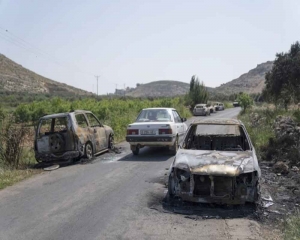The disappearance of sea ice in the Arctic not only spells disaster for the species inhabiting the region but is scripting a drastic shift in climatic conditions, which the world is not ready to tackle. We must wake up to this disaster before it’s too late
Climate change and the resultant rise in temperatures are finally breaking the colossal ice bastions. Ross Ice Shelf in Antarctica, which is roughly the size of France and the world’s largest ice cap, is fast melting than predicted. The melting has led to a global sea-level rise of around 13.8 millimetres over the last 40 years. This unsettling discovery was made by an international team of scientists. The research team also determined that the ice shelf is melting 10 times faster than the overall average due to solar heating of the surrounding ocean surface.
The latest study found that solar heating of the surface spurred the rate at which the ice is melting. The team collected data of over four years from an advanced oceanographic instrument installed under the ice shelf. Using instruments deployed through a 260 metre-deep borehole, the device measured temperature, salinity besides melt rates and ocean currents in the cavity under the ice.
The team also used an extremely precise custom-made radar system to survey the changing thickness of the ice shelf. Earlier, scientists believed that heat radiating to the bottom melted the underside of the shelf, while the ocean surface cooled down quickly. However, the latest findings show that heat in the ocean surface plays a crucial role.
Scientists suggest that climate change will only further the rate at which ice melts in the future. Antarctica comprises 90 per cent of the world’s ice. So what happens to its ice and snow is a matter of serious concern and if this situation continues, sea levels would rise up to 60 metres by 2050, which would cause the ocean to engulf coastal cities across the globe. Way back in 2007, the Intergovernmental Panel on Climate Change (IPCC) had estimated that the Arctic would have an ice-free summer by the end of this century. Additionally, predictions based on the US National Snow and Ice Data Center (NSIDC) made it evident that an ice-free Antarctica might be a reality sooner than later. According to the provisional satellite data produced by the NSIDC, there was just over 11.1 million sq km of sea ice in 2016 as compared to the 30-year average of 12.7 million sq km. The difference of more than 1.5 million sq km is more than four times the size of Germany.
The deteriorating state of affairs has not been sudden. The world had received a rude awakening in 2011 when NSIDC data had revealed that ice caps covered just 4.33 million sq km of the Arctic Ocean. A year later, the mid-September reading in 2012 measured it at 3.4 million sq km. Four years down the line, we are looking at a scenario where less than one million sq km of sea ice is a possibility. The year 2016 brought more bad news. The Arctic sea ice extent set a record low in March 2016. On March 24, Arctic sea ice extent was recorded at 14.52 million sq km, a record low ever since satellite observations started in 1979.
The sea ice extent is melting faster today than ever before. The enthusiasm in researchers and scientists to study more about the issue is now slowly turning to panic considering the far-reaching consequences on climate change. Currently, fractures in the ice cover are becoming more evident in the north of Greenland. Moreover, satellite images show that the fracturing of sea ice is more prominent in the Beaufort Sea, north of Alaska, where the ice is rapidly breaking up. This fracturing is a sign of a much thinner ice in the region that is typically the thickest and most durable. These findings are being made worse by the emergence of “unusually thin and even totally absent” sea ice covers on both the Atlantic and Pacific sides of the Arctic.
The first signs of rapidly warming Arctic are changing climate in Europe and the US. A team of researchers at the Rutgers University coined the term “Arctic amplification.” It refers to the enhanced sensitivity of high latitudes to global warming. Declining sea ice is one of the contributing factors to this phenomenon. Extreme weather in Western Europe and large swathes of North America is attributed to Arctic amplification.
According to climatologists, changes in jet streams, especially polar jets, are also linked to global warming. Jet streams are the ribbon of strong winds blowing high above in the atmosphere and exert huge influence on weather patterns. When the jet streams are warmer, their ups and downs become more extreme, bringing different weather to areas unaccustomed to climate variations.
With the warming of the Arctic and the loss of sea ice, scientists have observed that methane — a greenhouse gas — has started to bubble up to the surface at a precariously faster rate. Generally, it lies frozen on the seabed. One can’t be oblivious to another major concern: Having less sea ice would lead to higher absorption of the sun’s energy as the surface of the earth gets darker.
The rapid loss of the Arctic ice is not only spelling disaster for the species over there but also scripting a drastic shift in climatic patterns that the world is not ready to tackle. If humanity does not want to face the consequences of liquefied glaciers, it will have to find solutions that can arrest the melting of the Arctic.
(The writer is an environmental journalist)

























